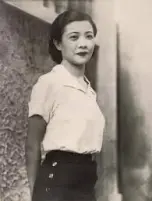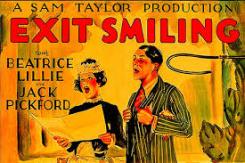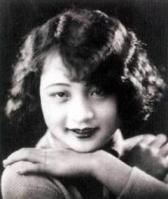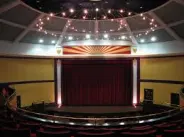Bo’Ness, Scotland
16-20 March 2016
 Having missed the opportunity a couple of times to get to HippFest, I decided that this year was going to be the one. We left London bright and early on Wednesday, in good time to make the first screening that night. And as usual, the journey north took longer than expected so we arrived at the Bo’Ness Hippodrome with barely enough time to take in the restored splendour of the cinema before the lights went down and
Having missed the opportunity a couple of times to get to HippFest, I decided that this year was going to be the one. We left London bright and early on Wednesday, in good time to make the first screening that night. And as usual, the journey north took longer than expected so we arrived at the Bo’Ness Hippodrome with barely enough time to take in the restored splendour of the cinema before the lights went down and  the first film, Earth (1930) hit the screen. Now I have to admit that I’m probably not Alexander Dovzhenko’s greatest fan. While his films do have a staggering beauty I do find the storylines somewhat slow, the montage scenes done better by others and the politics sometimes deeply suspect. And Earth is a case in point. It’s hard to sympathise with those smiling peasants rejoicing in the delights of collectivisation when we know that millions were dying of starvation as a direct result. And despite this apparently being a restored print direct from the Dovzhenko Foundation, I did find some of the inter-title translations a bit suspect and one or two missing altogether. However, on the positive side, the newly commissioned
the first film, Earth (1930) hit the screen. Now I have to admit that I’m probably not Alexander Dovzhenko’s greatest fan. While his films do have a staggering beauty I do find the storylines somewhat slow, the montage scenes done better by others and the politics sometimes deeply suspect. And Earth is a case in point. It’s hard to sympathise with those smiling peasants rejoicing in the delights of collectivisation when we know that millions were dying of starvation as a direct result. And despite this apparently being a restored print direct from the Dovzhenko Foundation, I did find some of the inter-title translations a bit suspect and one or two missing altogether. However, on the positive side, the newly commissioned  score from Jane Gardner and Hazel Morrison was excellent, capturing the feel of the film beautifully. Then it was time to wend our way to the hotel, adjacent to the largest oil refinery I’ve ever seen, a wondrous sight in darkness (just think of the opening scene of Blade Runner but on a bigger scale and with more jets of flame sprouting skywards!). Just a bit worried about a stray match!
score from Jane Gardner and Hazel Morrison was excellent, capturing the feel of the film beautifully. Then it was time to wend our way to the hotel, adjacent to the largest oil refinery I’ve ever seen, a wondrous sight in darkness (just think of the opening scene of Blade Runner but on a bigger scale and with more jets of flame sprouting skywards!). Just a bit worried about a stray match!
Thursday began with a trip to the Falkirk Wheel, a civil engineering marvel, connecting canals with a unique lift mechanism. Then it was back to HippFest and the first session of the day was a hugely informative presentation on Chinese silent cinema by Dr Xuelei Huang of Edinburgh University. This wasn’t a case of adding a bit to my  knowledge or filling in a few gaps. This was me starting from a zero base level of understanding on this subject so it was fascinating to discover the pace at which cinema took off in China with a first silent screening in 1896 only a year after the first Lumiere screening in France. Screenings spread rapidly and purpose-built cinemas soon appeared. Film superstars emerged, such as Ruan Lingyu (left) with mass followings. Film genres in China seemed generally to mirror those in Europe and Hollywood, particularly slapstick, costume dramas and a particular emphasis on family melodramas. It was also interesting to learn that Chinese martial arts films didn’t begin with Bruce Lee, they were already in production in the 1920s and 1930s. A reluctance to fund installation of sound equipment in many cinemas meant that the silent era continued in China until well into the 1930s. Yet as in the West, much of this output has sadly been lost. However, in China this was not just as a result of disinterest and film stock deterioration but also due to deliberate efforts to eradicate past output for political reasons. The range of clips chosen by Dr Huang presented a fascinating picture of
knowledge or filling in a few gaps. This was me starting from a zero base level of understanding on this subject so it was fascinating to discover the pace at which cinema took off in China with a first silent screening in 1896 only a year after the first Lumiere screening in France. Screenings spread rapidly and purpose-built cinemas soon appeared. Film superstars emerged, such as Ruan Lingyu (left) with mass followings. Film genres in China seemed generally to mirror those in Europe and Hollywood, particularly slapstick, costume dramas and a particular emphasis on family melodramas. It was also interesting to learn that Chinese martial arts films didn’t begin with Bruce Lee, they were already in production in the 1920s and 1930s. A reluctance to fund installation of sound equipment in many cinemas meant that the silent era continued in China until well into the 1930s. Yet as in the West, much of this output has sadly been lost. However, in China this was not just as a result of disinterest and film stock deterioration but also due to deliberate efforts to eradicate past output for political reasons. The range of clips chosen by Dr Huang presented a fascinating picture of  Chinese silent cinema both in terms of subject matter and technical sophistication.
Chinese silent cinema both in terms of subject matter and technical sophistication.
In the evening, we watched a screening of Mania (1918) starring Pola Negri (left). I’d seen a couple of Negri’s Hollywood films and not been  all that impressed but this was a revelation. Her acting ability, charm and sheer screen presence more than made up for the rather wooden leading man she co-starred with. Live musical accompaniment was provided by the Polish group Czerwie, in the form of a modern electronic score, perfectly complementing the film. So good in fact that I brought a copy on CD to accompany the long journey home.
all that impressed but this was a revelation. Her acting ability, charm and sheer screen presence more than made up for the rather wooden leading man she co-starred with. Live musical accompaniment was provided by the Polish group Czerwie, in the form of a modern electronic score, perfectly complementing the film. So good in fact that I brought a copy on CD to accompany the long journey home.
On Friday we visited the Kelpies, the largest equine statues in the world and a magnificent sight. Then at HippFest we had the pleasure of listening to Bryony Dixon (silent film curator at the BFI’s National Archives) talk about how Britain’s film industry supported the 1914-18  war effort. Clips screened showed examples of subtle and less subtle propaganda, including an early animated example of real ‘in your face’ propaganda condemning the German torpedoing of the liner Lusitania. Also very moving were ‘roll of honour’ films, compiled from still photos of dead, wounded or missing servicemen and screened in their local cinemas. This was an interesting and entertaining talk, albeit on a serious subject, emphasising that the film industry’s contribution to the war effort in 1914-18 was very similar in style and
war effort. Clips screened showed examples of subtle and less subtle propaganda, including an early animated example of real ‘in your face’ propaganda condemning the German torpedoing of the liner Lusitania. Also very moving were ‘roll of honour’ films, compiled from still photos of dead, wounded or missing servicemen and screened in their local cinemas. This was an interesting and entertaining talk, albeit on a serious subject, emphasising that the film industry’s contribution to the war effort in 1914-18 was very similar in style and  scale to its more widely recognised efforts in World War Two.
scale to its more widely recognised efforts in World War Two.
Friday ended on a much lighter note with a screening of Exit Smiling (1926) starring Beatrice Lille. Hailed by Noel Coward as “the funniest  woman of our civilisation”, this was Lille’s only foray into silent film. It was a joyous example of her comedic skills but also highlighted a Chaplin-esq talent for pathos with an ending that was more tragic than comedic. Accompaniment was by the excellent Neil Brand, playing on his birthday no less.
woman of our civilisation”, this was Lille’s only foray into silent film. It was a joyous example of her comedic skills but also highlighted a Chaplin-esq talent for pathos with an ending that was more tragic than comedic. Accompaniment was by the excellent Neil Brand, playing on his birthday no less.
 On Saturday, I ducked out of the morning comedy double bill and instead experienced the pleasure of a spin on the Bo’Ness and Kinneil Vintage Railway. This got us back just in time for a screening of a newly restored version of Variety (1925). This is a great film
On Saturday, I ducked out of the morning comedy double bill and instead experienced the pleasure of a spin on the Bo’Ness and Kinneil Vintage Railway. This got us back just in time for a screening of a newly restored version of Variety (1925). This is a great film  (despite the sight of Emil Jannings in tights!!) which I’ve seen before but never fails to delight. But today’s screening was special, firstly because the accompaniment from Stephen Horne and Frank Bockius was just out of this world and secondly because the quality of the restored print simply took your breath away. I’d also forgotten how good the female lead, Lya de Putti, was but have to confess I know next to nothing of her career. An urgent task when I get home is to find out more.
(despite the sight of Emil Jannings in tights!!) which I’ve seen before but never fails to delight. But today’s screening was special, firstly because the accompaniment from Stephen Horne and Frank Bockius was just out of this world and secondly because the quality of the restored print simply took your breath away. I’d also forgotten how good the female lead, Lya de Putti, was but have to confess I know next to nothing of her career. An urgent task when I get home is to find out more.
After a hasty lunch came the film I’d been looking forward to since  Thursday’s talk on Chinese silent film, Daybreak (1933) starring Chinese screen goddess Li Lili (left). What began as a family melodrama concerning country workers seeking their fortune in the city then moved slightly disconcertingly into the realms of nationalist propaganda and the bleakest of endings. Lili’s performance lights up the screen and the film effectively portrays both the idealistic beauty of the countryside and the frenetic pace of city life. John Sweeney’s piano
Thursday’s talk on Chinese silent film, Daybreak (1933) starring Chinese screen goddess Li Lili (left). What began as a family melodrama concerning country workers seeking their fortune in the city then moved slightly disconcertingly into the realms of nationalist propaganda and the bleakest of endings. Lili’s performance lights up the screen and the film effectively portrays both the idealistic beauty of the countryside and the frenetic pace of city life. John Sweeney’s piano  accompaniment, as always, captured the spirit of the film beautifully.
accompaniment, as always, captured the spirit of the film beautifully.
Saturday evening saw my only quibble with the festival scheduling, with what appeared to be an entirely avoidable programme clash forcing a choice between two films. I opted for The Wrecker (1929), in part because of the novelty of watching a film about trains screened on the platform of Bo’Ness railway station. This story of sabotage on the railways featured what was billed as ‘the most spectacular rail crash in cinema history’ but frankly this was a tad disappointing (had no one seen The General or Bridge on the River Kwai!) and was really a rather clunky British  comedy-thriller. Not to be outdone, we opted for a race worthy of a keystone chase back to the Hippodrome and, breaking the habit of a lifetime, opted to go in 15 minutes late to a screening. And what a wise move that was. The film in question was Wunder der Schopfung
comedy-thriller. Not to be outdone, we opted for a race worthy of a keystone chase back to the Hippodrome and, breaking the habit of a lifetime, opted to go in 15 minutes late to a screening. And what a wise move that was. The film in question was Wunder der Schopfung (1925), in effect a documentary outlining the then current state of human knowledge regarding the universe, so modern in its look that you expected Brian Cox to pop up any moment to take the story forward. Combining live action, some very clever animation and lots of stock footage, it was just stunning. Being late in, we missed the introduction by Prof. Brown, Astronomer Royal for Scotland, but gather this suggested that some of the scientific accuracy in the film was questionable, even in the 1920’s. But it didn’t matter, the visuals just took your breath away. And the electronic score by duo Herschel 36 was superb, fitting the images so well. I understand that this film and music are going on tour in Scotland shortly. One can only hope that this tour extends south of the border giving more people a
(1925), in effect a documentary outlining the then current state of human knowledge regarding the universe, so modern in its look that you expected Brian Cox to pop up any moment to take the story forward. Combining live action, some very clever animation and lots of stock footage, it was just stunning. Being late in, we missed the introduction by Prof. Brown, Astronomer Royal for Scotland, but gather this suggested that some of the scientific accuracy in the film was questionable, even in the 1920’s. But it didn’t matter, the visuals just took your breath away. And the electronic score by duo Herschel 36 was superb, fitting the images so well. I understand that this film and music are going on tour in Scotland shortly. One can only hope that this tour extends south of the border giving more people a  chance to catch such a great event (and me a further opportunity to see it).
chance to catch such a great event (and me a further opportunity to see it).
And all too soon we were on the last day of HippFest2016. Our first film of the afternoon was Peter Pan (1924), with Betty Bronson (personally selected by J M Barrie for the part) playing a petulant Peter Pan and George Ali  wonderful as the much-put-upon dog, Nana (and he also doubled as the crocodile!). The film looked beautiful and had the feel of a pantomime (there was even audience participation in bringing Tinker Bell back to life, yes I do believe in fairies, I do!!) One or two of the inter-titles were just hilarious, some intentional, others maybe less so. And the
wonderful as the much-put-upon dog, Nana (and he also doubled as the crocodile!). The film looked beautiful and had the feel of a pantomime (there was even audience participation in bringing Tinker Bell back to life, yes I do believe in fairies, I do!!) One or two of the inter-titles were just hilarious, some intentional, others maybe less so. And the  harp accompaniment by Elizabeth-Jane Baldry was superb, perfect for the film. Just a sheer delight.
harp accompaniment by Elizabeth-Jane Baldry was superb, perfect for the film. Just a sheer delight.
All that was then left was time for the closing gala, a nine handkerchief melodrama Stella Dallas (1925). This I had seen before but still worth watching again, with Belle Bennett excelling in what was a brave acting choice in the often less than glamorous title role. Also worth watching was Lois  Moran as her daughter. Who knows how her career would have gone if she hadn’t retired early from the screen. The film was accompanied by Stephen Horne on piano (and flute and piano accordion!! So much talent, its infuriating!) and Elizabeth-Jane Baldry on harp, with the premier of a new score composed by Stephen. Yet while I couldn’t fault either musician in any way I just wasn’t sure that a harp/piano combination worked all of the time. Maybe I need to see and hear this one again.
Moran as her daughter. Who knows how her career would have gone if she hadn’t retired early from the screen. The film was accompanied by Stephen Horne on piano (and flute and piano accordion!! So much talent, its infuriating!) and Elizabeth-Jane Baldry on harp, with the premier of a new score composed by Stephen. Yet while I couldn’t fault either musician in any way I just wasn’t sure that a harp/piano combination worked all of the time. Maybe I need to see and hear this one again.
Then, all too soon,the festival was over. So what were the ups and downs. Well in terms of films seen, I so enjoyed Mania (1918) and Wunder der Schopfung (1925). Musically, all the accompanists were  excellent although Stephen Horne and Frank Bockius were out of this world accompanying Variety (1925). But Czerwie and Herschel 36 amply demonstrated that modern electronic jazz/pop/rock scores can enhance a silent film just as well as traditional accompaniment. As for what I learnt, well I now know enough about Chinese silent film to know that I want to find out and see more. As for the downs, there weren’t many. Festival organisation was good with only one scheduling hiccup and everything ran pretty much to plan
excellent although Stephen Horne and Frank Bockius were out of this world accompanying Variety (1925). But Czerwie and Herschel 36 amply demonstrated that modern electronic jazz/pop/rock scores can enhance a silent film just as well as traditional accompaniment. As for what I learnt, well I now know enough about Chinese silent film to know that I want to find out and see more. As for the downs, there weren’t many. Festival organisation was good with only one scheduling hiccup and everything ran pretty much to plan  (although the 33 pages of A4 paper needed to print out our online tickets seemed a bit excessive!). In a similar vein, how good would it have been to be able to buy festival posters? And while no-one expects Bo’Ness to be a 24 hour city, it was a bit disheartening to find so many shops, cafes and restaurants closed so early in the day (thank heavens for Brian’s Café, a lifesaver on more than one occasion). But any downs were largely minor and did not detract from this being a great way to spend five days. I’m already looking forward to coming back for next year’s Hippodrome Festival.
(although the 33 pages of A4 paper needed to print out our online tickets seemed a bit excessive!). In a similar vein, how good would it have been to be able to buy festival posters? And while no-one expects Bo’Ness to be a 24 hour city, it was a bit disheartening to find so many shops, cafes and restaurants closed so early in the day (thank heavens for Brian’s Café, a lifesaver on more than one occasion). But any downs were largely minor and did not detract from this being a great way to spend five days. I’m already looking forward to coming back for next year’s Hippodrome Festival.
